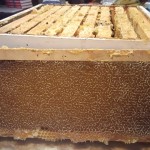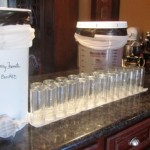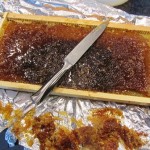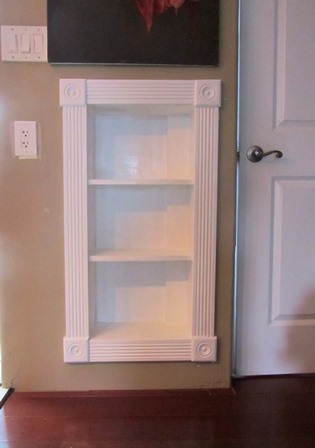Harvesting Honey–Helping Hands Always Welcome
When it comes to opening the hives of honey bees here on our farmette, I’m grateful for the helping hands of my hubby and my neighbor. Carlos, my hubby and helpmate for life, is my go-to guy for all our farm projects. And our neighbor Peter not only has answers to my questions about bees, but also he can open a hive, remove frames of honey, inspect and medicate, and seal the unit lickety-split.
With the smoker at the ready and lit, we opened our hives September 23, 2018. The hives were robust, but the bees appeared stressed. I had added supers to each hive in late July but should have kept a closer eye on the burgeoning bee population. They had become overcrowded and hungry.
For harvesting, we first removed the heavy metal lid of the hive box, replacing it with a fume board. A fume board is a lid lined with fabric that is sprayed with a product that encourages the bees to vacate the supers (some bees immediately leave the box; others go into the brood chambers). The fume board works within seven to ten minutes. We then pulled out the frames of honey, gently brushed off any remaining bees, and took the honey-heavy frames to the kitchen.
For an old hand at beekeeping like my neighbor, the process went quick. Not so for me. This past year, I injured both my shoulders with tears in the rotator cuff tendons. With limitation to some of my range of motion, I’ve felt pretty handicapped. Still, I helped by carrying a single frame of honey at a time from the hive box to the kitchen.
While the hives were open, we removed old medicated strips previously hung in the boxes to thwart mites.
- Small sheets for trapping hive beetles are placed across the frames in the top super before closing the lid
We also replaced the Bee-Gone sheets to trap hive beetles. It’s important to properly handle such items and to keep the apiary clean. We put in medication for mite control–a white gelatinous substance spread on a paper similiar to an index card. Finally, we placed a single patty of bee food on the frames to provide for the bees’ nutritional needs.
The bees immediately coalesced on the patty; no longer stressed, they seemed gentle and calm. Checking the bottom frames, we found a lot of brood (eggs, larvae and pupae of bees). To help this new generation of honey bees along, we inserted an unopened frame of honey that I’d kept wrapped in foil and frozen (freezing kills any insects that could infect the hive or bees). Honey, of course, is the perfect food for them.
We will reopen the hives in two weeks and re-check the status of the bees. A that time, we’ll treat with an antibiotic for winter and possibly add a super if necessary.
I haven’t yet processed the honey we harvested but the frames are on my kitchen counter. They are in a hive box wrapped in aluminum foil. At the ready are also several food-grade buckets that I’ve carefully washed, dried, and covered with lids. The honey spinning machine has been cleaned. Before I begin working with the honey in the frames, I always scrub my kitchen, washing the countertops twice–first with soap and water and then with diluted bleach and hot water.
When everything is clean, I will begin to work on each frame. I first scrape away any bee “glue” from the outside edges of the frame. With a hot knife, I slice all around the interior edges before opening the sealed wax cells (sliding the hot knife just under the wax and lifting). Both sides of the frame are dealt with in this manner. After the wax cells are uncapped, the frame will be placed into the spinning machine. It uses centrifugal force to spin off the honey. The sweet stuff then drains through the strainer material taped around the bucket mouth. The bucket is positioned under the machine spigot.
My reward for this labor of love is having an abundance of sweet, amber honey when desired to bake a honey cake or other culinary creation, to enjoy a relaxing cup of tea, or to fill jars for holiday gift-giving. Beekeeping draws people together and, take it from me, a helping hand is always appreciated.
_______________________________________________________________________________
If you enjoy reading about keeping bees and chickens, growing heirloom vegetables and fruits, or living the farmette (small farm) life, check out my offering of books that tie into themes of living well and close to the Earth.
Grab one or more of my cozy mysteries (no gratuitous sex, profanity, or violence) and discover delicious farm recipes, gardening advice, and tips for caring for bees and chickens.
Or pick up one of my wellness, spirituality, or manifesting books. They make great holiday gifts for yourself and others.
All my books are available in traditional bookstores everywhere and also online at Amazon.com, Barnes & Noble (barnesandnoble.com), Kobo Books, Walmart, and other retailers.
For more information, click on the following URLs:
A HIVE OF HOMICIDES
MURDER OF A QUEEN BEE
A BEELINE TO MURDER

More than 150 rituals for sound mind, strong body, and meaningful connections to the people around you
https://www.amazon.com/dp/B0719HHVRJ/ref=dp-kindle-redirect?_encoding=UTF8&btkr=1
Creating Functional Space in Our Small Farmhouse Kitchen
“There’s never enough storage space!” It’s become a lament I want to banish from my frequent utterances.
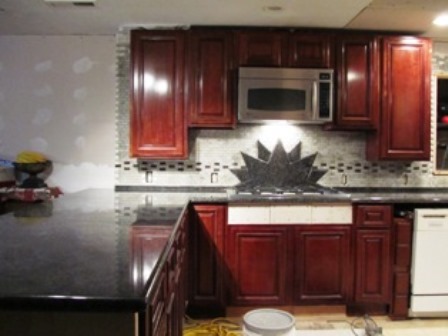
Our farmhouse kitchen counter and cabinets during early renovation. Carlos cut the sunburst pattern from blue-black granite
At roughly 1,000 square feet, our house isn’t terribly small by the 1970’s standard when the average American home was 1,400 square feet. And by the 195o’s standard of 983 square feet, my house is positively roomy. However, today, the average American house footprint stands at 2,598 square feet. That said, there is a tiny house movement on and that’s a good thing for the environment.
Having lived in larger houses, I can honestly say I love this smaller home. The costs for energy, upkeep, homeowner’s insurance, and property taxes are considerably less. The need for interior furnishings shrinks, too.
The downside is there is less space for storage. We have had to maximize our options. I keep bees and beekeeper supplies like honey jars and lids as well as my cases of jam jars and lids and the final, finished products have to be stored somewhere. And then there are my cookbooks (I’ve cut the collection from over a hundred to a quarter of that).
My designer/architect husband Carlos Carvajal came to my rescue by carving out some space for bookcase in the wall between the kitchen and the bar area.
He also took space from the kitchen to create a laundry area with washer and dryer and hid them behind bi-fold doors.
The bar area has a bank of lower cabinets that can hold glassware, appetizer dishes, and serving platters. He re-created a new cabinet unit from a bank of old upper kitchen cabinets, mounting them on the wall above the granite counter-top with an inset sink.
A narrow moveable butcher block cart on wheels with a couple of shelves could give me a little extra storage, if we could find one that would fit in the limited space near the oven.
I think we’ve maximized our storage options in the kitchen and created a highly functional space so maybe I can now abandon that lament.
 Facebook
Facebook Goodreads
Goodreads LinkedIn
LinkedIn Meera Lester
Meera Lester Twitter
Twitter




